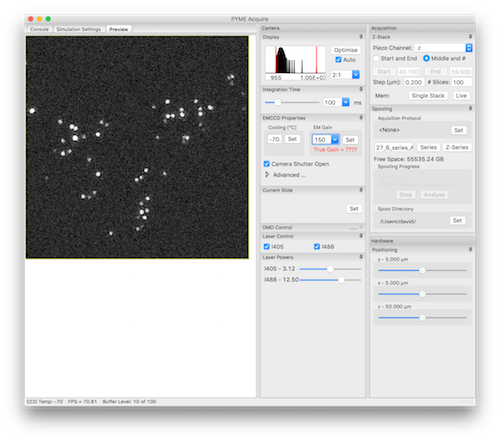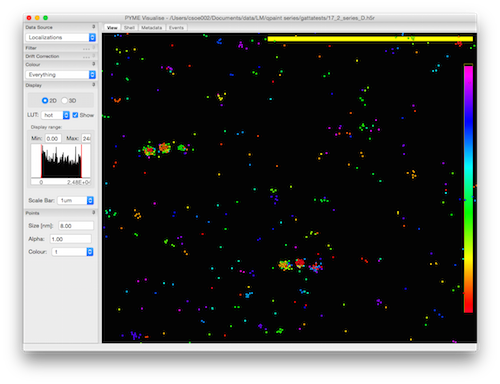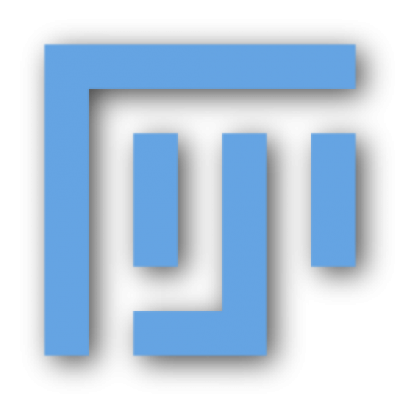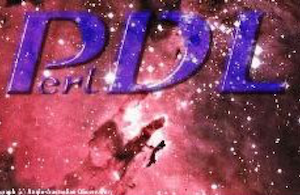The laboratory fully supports open source and sharable code resources. Code and software play an important role in our work and we are both active users of open software and are actively contributing the code and algorithms that we develop back to the community.
PYME - the Python Microscopy Environment

PYME is a microscopy software environment designed and implemented by our colleague David Baddeley. David worked with us for several years, a large part of the SMLM functionality was tested and implemented while working together at the University of Auckland. David has continued to develop this package and we regularly contribute code and extensions. PYME offers a data acquisition module which performs the microscope and camera control functionality similar to that offered by e.g. micro-manager, but optimised for PALM/STORM type imaging. The PYMEAcquire GUI interface is highly configurable and has backends for a range of different hardware in terms of cameras, microscopes, etc. We run it on a range of custom built microscopes. A major strength is the flexible extensibility resulting from being built within the powerful Python framework.

PYME also has a PALM/STORM data exploration and visualisation tool, VisGUI. VisGUI offers a fast and flexible tool for exploring and visualising the list of fluorophore locations that is produced by PALM/STORM analysis algorithms. VisGUI renders localisations in various different ways and can filter and process localisation events in powerful and flexible ways. Recently, we have implemented extension plugins to experiment with the qPAINT quantitative imaging paradigm and the powerful Python based infrastructure enabled the implementation of cluster based processing with relative ease.
PYME is not limited to super-resolution microscopy. It can also deal with various types of confocal data - it provides powerful deconvolution and 3D visualisation tools.
PYME github repositories
We maintain several repositories on github that contain our acquisition, analysis and control codes for various types of microscopy.
- python-microscopy - a fork of David's python-microscopy with our pull requests etc
- pyme-extra - extra plugins for PYME, including qPAINT, camera map tools, etc
- pyme-cs-siteconfig - PYME site specific init files and custom protocols
- pyme-extra-sample-data - PYME sample data for tests and illustrations plus some code examples
- pyme-apps - macos lightweight app wrappers for PYME using the platypus app builder
ImageJ/Fiji
 Fiji
is an image processing package—a "batteries-included" distribution of
ImageJ, bundling a lot of plugins which facilitate scientific image
analysis.
Fiji
is an image processing package—a "batteries-included" distribution of
ImageJ, bundling a lot of plugins which facilitate scientific image
analysis.
![]() Fiji comes in
handy all the time for various smaller and larger jobs on image
processing. Its GUI interface makes it very suitable for beginners,
students and all those who are not yet experts in writing their own
code with Python, IDL or similar languages.
Fiji comes in
handy all the time for various smaller and larger jobs on image
processing. Its GUI interface makes it very suitable for beginners,
students and all those who are not yet experts in writing their own
code with Python, IDL or similar languages.
We do not contribute ourselves to Fiji/ImageJ but promote its use and support as a great example of an open software tool that has become very useful and allows access to high quality image processing for those who are not programmers at heart.
We recommend using Fiji over standalone imageJ as the updating mechanism and plugin handling is vastly superior in Fiji which essentially wraps a package manager type application around ImageJ and therefore makes maintenance a breeze.
PDL
 Now of
mostly historical interest, CS is one of the original core developers
of PDL, an array language like matlab, IDL, or
numpy, which is based on the Perl scripting
language.
Now of
mostly historical interest, CS is one of the original core developers
of PDL, an array language like matlab, IDL, or
numpy, which is based on the Perl scripting
language.
PDL ("Perl Data Language") gives standard Perl the ability to compactly store and speedily manipulate the large N-dimensional data arrays which are the bread and butter of scientific computing.
PDL turns Perl into a free, array-oriented, numerical language similar to (but, we believe, better than) such commercial packages as IDL and MatLab. One can write simple Perl expressions to manipulate entire numerical arrays all at once. Simple interactive shells are provided for use from the command line along with the PDL module for use in Perl scripts.
PDL was the first larger open software project that CS had become involved with. One of the nicest side effects was getting to know two fellow academics and programmers, Karl Glazebrook who is now a professor of astronomy at Swinburne and Tuomas Lukka who is now chief scientist at Zen Robotics.